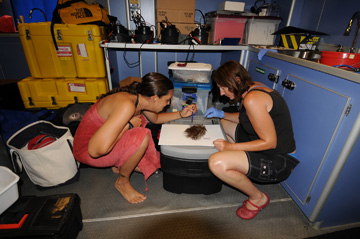INTRODUCTION

From general exploration and habitat characterization to investigations of specific research questions to routine monitoring of
resource health, science in Flower Garden Banks National Marine Sanctuary plays a vital role in making
informed resource management decisions.

A hawksbill sea turtle rests on the reef as divers
work nearby. Photo: Hickerson/FGBNMS
Information gathered by the sanctuary science team and our partners
provides the information necessary to expand upon existing baseline data, compare existing habitat conditions with past
conditions, and allocate limited resources to effectively target the most important management issues with research
efforts.
Flower Garden Banks National Marine Sanctuary strongly encourages researchers and students to conduct their scientific studies at the site. In particular, the sanctuary encourages science that supports management concerns.

A hunchback scorpionfish as seen by an ROV
The logistics of conducting research at this site can often be challenging, given the distance from shore and limited access to the reef. Although we are usually unable to support projects through funding, we support research by facilitating access to the site.
Most research activities require a permit from the sanctuary. Interested graduate students and principal investigators should contact the Research Coordinator to
discuss their research ideas prior to launching a project.
OUR RESEARCH TEAM

In general, the research team is made up of a Research Coordinator, Research Specialist(s), Research Assistant(s), and Research Intern(s). The Sanctuary Superintendent also plays a major role in developing research strategies and participating in research activities.

Two members of the research team examine a
sample collected using an ROV.
The crew of the R/V MANTA is an extension of the Research Team. Working closely with the crew is our NOAA Corps Officer, who holds the role of Marine Operations Officer. Together, these people are crucial to the success of the research objectives.
Learn more about sanctuary staff
OUR RESEARCH VESSEL

The R/V MANTA, a custom built research vessel, was dedicated in 2008. After a challenging beginning, the 2009 field season was our first successful year of operations. This vessel has become the centerpiece of our research activities.

R/V MANTA
Photo: All American Marine
Learn more about the R/V MANTA
SCIENCE DOCUMENTS

Links to download science and research documents are available throughout this website. They are also clustered together in the Science section of our Document Library for easy acess.
Web versions of some reports are also available:
2012 Research Summary (4.3MB pdf)
2011 Research Summary
2010 Research Summary
2009 Research Summary
2008 Condition Report
2008 Research Summary
top of page